LIRR - Chestnut Street Junction
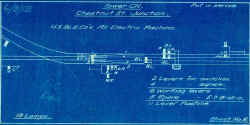
Chestnut St. Jct. CN Tower 6/13/1912 Archive: Art Huneke
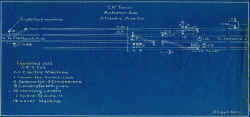
Interlocking CN Tower 1922
Archive: Art Huneke
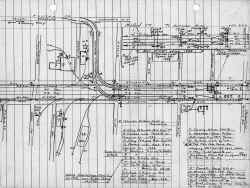
Chestnut Street Jct. Milford St. to Autumn Ave. Emery Map pre-1942
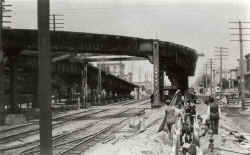
BRT - LIRR Chestnut St. incline view E 1905 Archive: Art Huneke
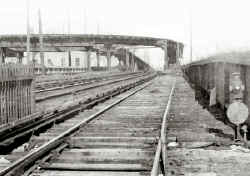
Chestnut St. connection at LIRR Autumn Ave. view E 1906
Archive: Art Huneke
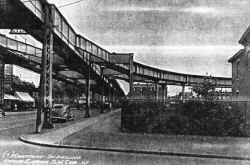
Former BRT line (1896–1923) LIRR/Chestnut St. connection at the BRT end ( Third rail to third rail.) The BRT (later BMT 1923-1940) Fulton Line paralleled the LIRR's Atlantic Branch at this point. The BRT (BMT) elevated tracks curving to the right are heading south to the LIRR's tracks at "CN" tower. View E c.1936 Archive: Art Huneke Research: Dave Keller
Note: Interesting is that the Chestnut
St. connection is at Chestnut St. ONLY at the BRT/BMT end. The
LIRR's connection is at Euclid Avenue, one block EAST of Chestnut St.
yet it was called the Chestnut St. incline and the Chestnut St. Jct.
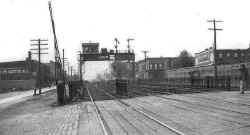
CN Tower Chestnut St. Junction view W 1923 (James V. Osborne photo, Dave Keller archive)
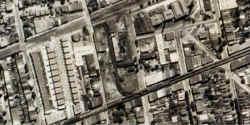
Chestnut St. connection Aerial 1924
Robert Emery notes: Connection to BRT put in at Chestnut
Street: 07/17/1898. Used until 1917, torn down: 1940(?)
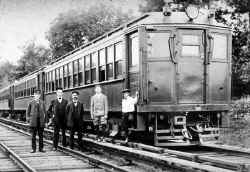 This was a
BRT-style coupler, as these MP41 cars were built to run in joint LIRR/BRT operation (which ended in 1917) and were even nicknamed "Gibbs Cars" after the guy who designed the similar electric passenger cars for the
BRT. After purchasing a bunch of these cars in 1905 for operation in newly-electrified territory, the LIRR purchased new MP54 cars in 1909-10. The shorter, MP41 cars were eventually relegated to rapid-transit service along the Atlantic branch and the longer and newer MP54 cars were used in the rest of electrified territory. I've never seen the coupler pushed over to one side like that.
The last two MP41 cars to see LIRR service (#'s 1100, 1101) were used on the Mitchel Field Shuttle into the late 1940s, when they were replaced by two MP54 cars. (See image above from 1908 and note the coupler.) Archive/Info: Dave Keller
This was a
BRT-style coupler, as these MP41 cars were built to run in joint LIRR/BRT operation (which ended in 1917) and were even nicknamed "Gibbs Cars" after the guy who designed the similar electric passenger cars for the
BRT. After purchasing a bunch of these cars in 1905 for operation in newly-electrified territory, the LIRR purchased new MP54 cars in 1909-10. The shorter, MP41 cars were eventually relegated to rapid-transit service along the Atlantic branch and the longer and newer MP54 cars were used in the rest of electrified territory. I've never seen the coupler pushed over to one side like that.
The last two MP41 cars to see LIRR service (#'s 1100, 1101) were used on the Mitchel Field Shuttle into the late 1940s, when they were replaced by two MP54 cars. (See image above from 1908 and note the coupler.) Archive/Info: Dave Keller
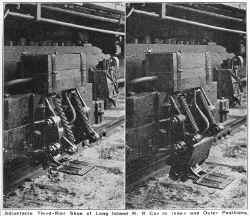 MP41
convertible third rail shoe from the LIRR to the BMT
MP41
convertible third rail shoe from the LIRR to the BMT
THE MP41s by Joe Frank
The MP-41's were nearly exactly the same cars as the IRT Gibbs
cars. "The first steel LIRR 1907-8 built "MU Cars" were really exact carbody copies of the earlier 1903-4 built IRT "Gibbs" Hi-V Cars...and were classified by the LIRR as MP-41 cars. They were the SAME size (8'10" wide x 51' long) as the IRT Gibbs cars, because the LIRR and IRT had designs on some joint operation between IRT and LIRR routes. This never came to happen.
They could MU and train Line with IRT cars technically...but unlike the IRT cars, the LIRR cars were built with end traps and stepwells and the trucks had a modified form of "cowcatcher" on their end facing ends, and of course, along with the IRT style roof marker lights...the LIRR cars ALSO used a center headlight...originally an IRT EL "elevated type" headlight unit, and that was later replaced by the 1915-18 era by the standard LIRR Box Headlight common to the wider and longer, later LIRR MP-54 cars, on the roof.
These LIRR cars, also unlike their IRT mates, lived their lives WITHOUT a center door added, and kept their Vand Dorn Link & Pin couplers
throughout their service life...1908 thru 1955-6, unlike the IRT subway cars, whose were replaced about 1910-15.
The LIRR and IRT "Gibbs" class and designed cars started out with very slight modified version of Manhattan Elevated Car "Manhattan" seating...and LIRR cars retained it thru their entire lives. The center cross seat on the IRT Gibbs were removed by 1908-10 for installation of the center side doors...thus retaining only their wall bench seats. They both also had end vestibule-bulkhead twin sliding doors, which closed off the entire vestibule platform on the motorman-operating end, to the motorman.
The LIRR Steel Gibbs cars, being IRT Subway and El, and BMT EL car widths (almost 9")...did run to Manhattan via the BMT El's and Brooklyn Bridge, as well as to Delancey Street on the Broadway Brooklyn BMT EL under joint
BRT-LIRR operation. however, they never ran on the IRT subway in revenue service, tho the
IRT-LIRR connection was in place at their joint Atlantic Avenue stations for a few (the first early) years.
When the LIRR started operation (about 1912-14) of their new, longer and wider MP-54's, which had MCB Knuckle Couplers, the LIRR MP-41 Gibbs cars eventally had all their end vestibule hinged platform traps replaced with wider traps that protruded outward alomost 6" from the carbody side end doors and car sides when lowered to meet the vestibule floors. This was to allow these cars to operate on lines with the new wider cars, and close up the platform gap clearances used for operating the major fleet of LIRR wider body Fleet of
MP-54.
The BRT was incorporated January 18,1896 Brooklyn Daily Eagle page one. July 17th, 1898 saw the first joint service between the Brooklyn Elevated Railway and the LIRR. The Chestnut Street incline opened connecting the Broadway - Brooklyn El to the LIRR at Atlantic Avenue and Rockaway Avenue. El trains ran through to Rockaway Park. On October 4th, LIRR Ferry to Jamaica using the incline. This service lasted only three months, ending January 10th, 1899.